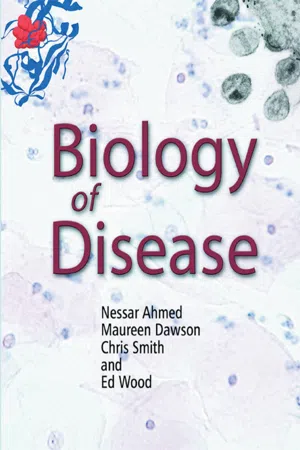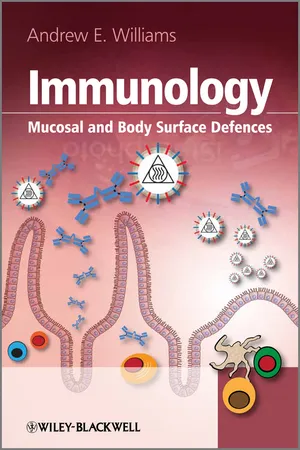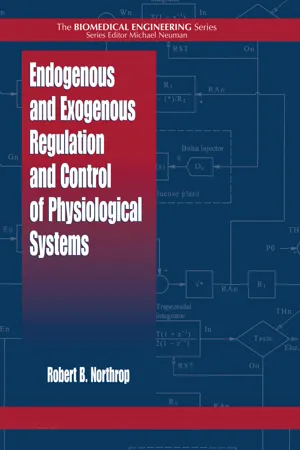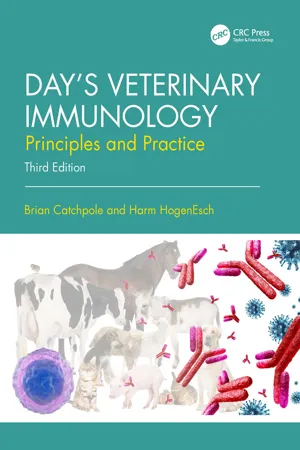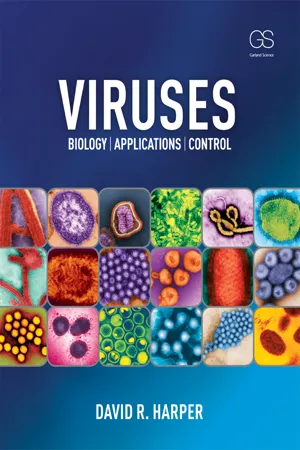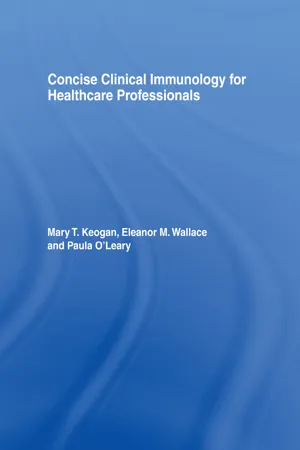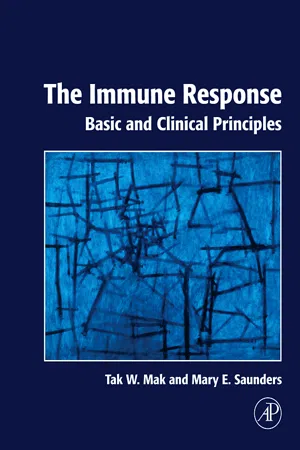Biological Sciences
Immune Response
The immune response is the body's defense mechanism against foreign invaders, such as pathogens and harmful substances. It involves a complex network of cells, tissues, and organs that work together to identify and eliminate these threats. The immune response can be categorized into innate and adaptive immunity, each playing a crucial role in protecting the body from infections and diseases.
Written by Perlego with AI-assistance
Related key terms
9 Key excerpts on "Immune Response"
- eBook - ePub
- Nessar Ahmed, Maureen Dawson, Chris Smith, Ed Wood(Authors)
- 2007(Publication Date)
- Taylor & Francis(Publisher)
chapter 4 THE IMMUNE SYSTEM
OBJECTIVESAfter studying this chapter you should be able to:- give an account of the role of the immune system in maintaining health;
- explain the difference between nonspecific and specific immune defenses;
- describe the cells of the immune system and outline their roles in immune defense;
- explain the roles of major proteins involved in immune defense;
- describe the major features of inflammation and the acute phase response;
- describe the major features of humoral and cell-mediated specific immunity;
- outline the use of antibodies for detecting and quantifying molecules of biomedical significance.
4.1 INTRODUCTION
The immune system is a set of organs, tissues, cells and molecules that protect the body from disease caused by microorganisms and multicellular parasites (Chapter 2 ). Immunology is the study of the immune system and how it works. Unraveling of the mechanisms of immune defense and the use of products of the immune system in investigating and treating disease has revolutionized the biomedical sciences in a way that is comparable to that of molecular biology in recent years. This chapter describes the major components of the immune system and explains how a coordinated Immune Response is produced against infectious agents. In addition, the use of immunological techniques in the biomedical sciences will be outlined.4.2 TYPES OF IMMUNE DEFENSE
The immune system has to distinguish between the cells and macromolecules that make up the body that is, self, and those that are foreign or nonself. Immunological defenses are usually classified as nonspecific and specific. Nonspecific defenses constitute a first line of defense and are available immediately any foreign material, including substances such as wood splinters as well as microorganisms, enters the body. Nonspecific defenses include responses such as inflammation, a rapid immediate response to tissue damage, and the acute phase response, a relatively rapid response to infection. In specific immunological defense, cells of the immune system recognize not just individual microorganisms, but also the particular proteins or glycoproteins found on that microorganism. This type of defense may take several days to become effective, depending on whether the immune system was previously exposed to that specific microorganism but, once activated, results in a long-lasting immunity to it. This immunity can be humoral, in that it involves the production of antibodies and/or cell-mediated, which involves the production of cells that kill or recruit other cells to kill the infected cells. Humoral immunity is effective against microorganisms that do not invade cells and this includes most bacteria and multicellular parasites (Chapter 2 - eBook - ePub
Immunology
Mucosal and Body Surface Defences
- Andrew E. Williams(Author)
- 2011(Publication Date)
- Wiley(Publisher)
Figure 1.5 ), while subsequent chapters aim to provide detailed descriptions of specific immunological mechanisms.1.3 Activation, Regulation and Functions of Immune ResponsesFigure 1.5 Key concepts in the development of an Immune Response. First pathogens must be detected and recognised as a threat. This pathogen recognition then activates the immune system and results in immune function, which can be divided into antibody-mediated or cell-mediated immunity. The functional activity must then be regulated after the pathogen has been dealt with and is known as immune regulation.One of the most important concepts in immunology is the recognition of foreign substances by the immune system. For example, microorganisms such as bacteria and viruses produce a multitude of proteins, carbohydrates and glycolipids, which can all be recognized by cellular receptors expressed on the surface of immune cells. The most widely studied family of microbial recognition receptors are known as pattern recognition receptors (PRRs), because they recognize evolutionary conserved molecular patterns produced by microorganisms. The recognition of microbial products, which are known as pathogen associated molecular patterns (PAMPs), is one of the first steps in the activation of an Immune Response. Numerous cells of the immune system, and also tissue cells such as epithelial cells, express these PRRs. Probably the most ubiquitous family of PRRs are known as the toll-like receptor (TLR) family, which are responsible for the recognition of a host of PAMPs (discussed further in Chapter 2). The recognition of foreign molecules activates immune cells and results in the initiation of an Immune Response. For these reasons PAMPs are often referred to as danger signals. This is one way in which the immune system is able to discriminate between foreign substances (non-self) and its own molecules (self). - Robert B. Northrop(Author)
- 2020(Publication Date)
- CRC Press(Publisher)
10 The Human Immune System Seen from a Biomedical Engineering Viewpoint 10.0 INTRODUCTION In the opinion of the author, the human immune system is, compared to the central nervous system (CNS), the second most complex physiological system in the body. In order to manipulate its components by exogenous means to better fight diseases, we must attempt to understand the vast network of complex, causal interactions among its various components. These interactions are, in general, of a feedback as well as a feedforward nature. The immune system’s components are self-regulating; i.e., the system is homeostatic. The components include specialized immune cells, the immunoregulatory autacoids they secrete, and the antibodies manufactured. The immune system responds to biochemical signals (autacoids) from immune system cells at the sites of infection, from the CNS, and from other tissues. Certain cellular components of the immune system are mobile and can move throughout the body’s circulatory and lymphatic systems. Some of the immune system cells end up being fixed in certain tissues and organs. The function of the immune system is to seek out and destroy invading bacteria, fungi, molds, viruses, protozoa, spirochetes, parasites, etc. Immune surveillance extends under certain conditions to the detection of cancer cells and their destruction. Immune system macrophages (monocytes) also act to clean up necrotic body tissues damaged by injury or disease. As we shall see, the immune system uses several mechanisms in its mission. These include humoral (molecular) factors, including antibodies (Ab) and complement, and direct cellular attack, including phagocytosis and lysis. Macrophages, natural killer (NK) cells, and cytotoxic T-cells (CTL) participate in the direct cellular attack of hostile invaders. The immune system also can respond to substances to which it should not react. These responses include allergy and autoimmunity. Certain foods, drugs, etc- eBook - ePub
Day's Veterinary Immunology
Principles and Practice
- Brian Catchpole, Harm HogenEsch(Authors)
- 2023(Publication Date)
- CRC Press(Publisher)
Figure 1.1 ).The immune system is intrinsically involved with the inflammatory response and tissue repair processes of the body. In addition to responding to external threats (i.e. foreign organisms), the immune system can also initiate responses to abnormal cells (i.e. altered self) that can arise during neoplastic transformation or against cells/tissues that have been transplanted into the body. Such a potent biological defence system requires careful management and regulatory mechanisms have evolved to ensure Immune Responses are measured and appropriate, so as not to cause collateral damage to normal body tissues. Unfortunately, this sometimes goes awry and the immune system can initiate inappropriate responses to innocuous environmental antigens, dietary antigens or healthy cells/tissues, leading to immune-mediated allergic and autoimmune diseases that are so important in human and companion animal medicine.Figure 1.1Pathogens infect and replicate at different locations. Some pathogens seek to colonize epithelial surfaces of the skin and mucosal epithelium. Others invade and infect tissues, replicating in the extracellular fluid, intracellular fluid or within intracellular vesicles, following endocytosis.The immune system has evolved from humble beginnings in unicellular organisms to become the complex system of cells, tissues and molecules that we see in mammalian species. The immune system of all animals utilizes a similar ‘toolbox’ of components that interact with each other in a predictable fashion. Immunology is relatively advanced in human medicine and in the study of rodent species used as experimental models in research, when compared with those species that fall under the remit of veterinary medicine. However, it is possible to extrapolate many of the fundamental immunological principles from the better explored species to domestic animals. That said, there are numerous intriguing species differences that have arisen during evolution and these will be highlighted in the chapters that follow. - eBook - ePub
Viruses
Biology, Applications, and Control
- David Harper(Author)
- 2011(Publication Date)
- Garland Science(Publisher)
oncogenesis).The human Immune Response to virus infection consists of two main parts. The innate immune system mounts a rapid, generic response by recognizing non-self molecules—those which are different to those of the host—on the surface of invading viruses. This rapid response is then followed by the adaptive immune system, which is slower to develop but has the ability to recognize specific pathogens and target them for destruction. There are two strands to the adaptive response: the serological (or humoral) system, which is mediated by antibodies produced by B cells, and the T-cell-mediated system. The main properties of the innate and adaptive Immune Response are summarized in Table 4.1 .Table 4.1 The innate and adaptive Immune ResponsesImmune Response Type Speed Receptors Effectors Effect Innate Non-cellular Fast Preexisting (encoded in the genome) Cytokines (interferons), complement Localized response to infection, stimulation of general Immune Response Cellular Fast Preexisting (encoded in the genome) Macrophages and other phagocytic cells, NK cells Engulfment of pathogens, release of cytokines Adaptive Non-cellular Slow (on first exposure) On B cells, produced by genetic rearrangement and amplified by clonal selection. Bind to antigens via B-cell receptor and present via MHC-II pathway - eBook - ePub
- Philias R. Garant(Author)
- 2020(Publication Date)
- Quintessence Publishing Co, Inc(Publisher)
Immune SystemD uring the course of evolution, a complex immune system arose for the recognition of nonself from self at the molecular level. Whether it is an invading bacterium, a virus, or a host cell that has acquired new characteristics that make it no longer responsive to normal controls, the offender must be identified and destroyed.The oldest form of defense is provided by the innate immune system. This system is based on the evolution of host cell (and soluble) pattern recognition receptors and natural antibodies that bind specific classes of complex carbohydrate molecules expressed on microbial surfaces.1 Pattern recognition proteins are preexistent, waiting for some future encounter with a known foreign invader. Pattern recognition molecules include mannose-binding lectin and Toll-like receptors that act as receptors for surface components of Gram-positive and Gram-negative bacteria, respectively. Receptor-ligand interactions on host defense cells, such as monocytes, macrophages, and neutrophils, activate several innate systems for killing the invading organisms. The complement system is a key component of the innate immune system. Additional discussion of innate immunity is contained in chapter 14 .This chapter will focus on the adaptive immune system, involving highly specific recognition of foreign proteins and/or polysaccharides by surveillance cells and the subsequent activation of antigen-specific T and B lymphocytes. Unlike pattern recognition molecules of the innate immune system, the defending proteins (antibodies) of the adaptive immune system are extremely specific and manufactured on order. They are the product of a more sophisticated system, one that enables the host to develop a defense against a totally new foreign protein. - Mary Keogan, Eleanor M. Wallace, Paula O'Leary(Authors)
- 2006(Publication Date)
- Routledge(Publisher)
Together, the innate and adaptive immune systems provide an amazing defence system. Despite the fact that we are surrounded by a multitude of potentially pathogenic microorganisms, we rarely succumb to infection. Many infections are eliminated by the innate immune system and cause no disease. Infections that cannot be resolved by innate immunity trigger adaptive immunity, which usually eliminates the infection (often before we are aware of it) and generates immunological memory.WHAT HAPPENS WHEN THE IMMUNE SYSTEM GOES WRONG?
The immune system is only apparent when it goes wrong, and virtually any clinical presentation may be the sign of an underlying immunological disorder. The immune system must find a balance between producing a life-saving response to infection and tissue-damaging reactions. It is also essential that the immune system only mounts a vigorous response to pathogens that pose a threat, and ignores our own tissues, as well as environmental substances including foods and medicines.Immunodeficiency diseases
Immunodeficiency means a failure of the immune system to protect us from infection. It may be primary (due to an intrinsic defect in the immune system) or secondary, (due to drugs, infection, malnutrition etc.).Overactivity of part of the immune system
The Immune Response can cause incidental tissue damage as well as the intended removal and/or destruction of microorganisms. Additionally the immune system may fail to distinguish between pathogens and innocuous stimuli such as pollen or self-tissue. In this case a vigorous Immune Response causes disease.Allergy
An over-response to environmental stimuli, which pose no threat, is called allergy. Several different immune mechanisms may be involved. The most common mechanism causes rapid responses varying in severity from hayfever to potentially fatal anaphylactic shock.Autoimmunity
Autoimmune diseases can affect any tissue in the body, and occur when the immune system fails to distinguish between self (which should be ignored) and non-self (which should be attacked). Many autoimmune diseases can be diagnosed by testing for immune products (antibodies) against self-tissues in patients’ blood.- eBook - ePub
The Immune Response
Basic and Clinical Principles
- Tak W. Mak, Mary E. Saunders, Maya Rani Chaddah, Wendy Lynn Tamminen(Authors)
- 2005(Publication Date)
- Academic Press(Publisher)
Chapter 4 .B. General Features of Adaptive Immunity
Adaptive Immune Responses differ from innate Immune Responses in five key aspects: specificity, memory, diversity, tolerance , and the “division of labor” that has evolved to share the load among various cells, tissues, and soluble products. The quest to understand the cellular and molecular mechanisms underlying these features drives the bulk of modern immunologic research. We will briefly summarize each of these important concepts in turn, as the ideas involved will recur throughout this book.I. SPECIFICITY
Specificity in the adaptive response context means that all phases of the response are specific to a unique antigen, from the recognition of the antigen either by antibody (humoral response) or T lymphocyte (cell-mediated response), through lymphocyte activation, to effector function (action by antibody or T lymphocyte to eliminate antigen) and the development of immunologic memory (see later). This specificity is mediated by the existence on T and B lymphocytes of antigen-specific receptors that must interact with antigen before a lymphocyte can be activated. Although this is often interpreted as “one lymphocyte recognizes one antigen,” specificity is more accurately defined at the molecular level as “one lymphocyte has one antigen receptor gene that is expressed to generate thousands of identical copies of one receptor protein.” The distinction made by the molecular-level definition is important, since a lymphocyte can in fact recognize more than one antigen: different molecules closely related in shape or amino acid sequence may all bind to a given antigen receptor with varying degrees of strength. Nevertheless, the range of binding specificities of an individual lymphocyte is very narrow compared to the much broader recognition capacity of an individual cell of the innate system. Recognition structures of the innate system are designed to respond to antigens shared by a wide variety of pathogens, while binding to a lymphocyte antigen receptor is much more restricted and usually hinges on the presence of a unique feature unlikely to appear on more than one pathogen (Fig. 2-1 - eBook - ePub
Exploring Immunology
Concepts and Evidence
- Gordon MacPherson, Jon Austyn(Authors)
- 2013(Publication Date)
- Wiley-Blackwell(Publisher)
As a first general rule, the type of innate or adaptive response that occurs after infection is tailored to the type of infectious agent that initiated it. Thus, the immune system generates an Immune Response that is most appropriate for eliminating the infectious agent. For example, we have seen above that phagocytes are involved in direct killing of bacteria, cytotoxic cells can kill cells that have been infected by viruses, and eosinophils and basophils may help in resistance to worm infestations. Each of these cell types uses very different mechanisms to perform its functions.A second general rule is that cells that are involved in any Immune Response do not act independently, they are regulated by, and can regulate the functions of, other cells. The production of innate cells from the bone marrow may be increased or decreased during both innate and adaptive responses, their accumulation at sites of infection is regulated by inflammation and, importantly, their functions can be modulated. In this way each cell can help to fine tune the type of Immune Response that needs to be induced at different times after infection.It is a third general rule that all Immune Responses need to be initiated, particularly in response to infection, and that the overall response needs to be properly coordinated and regulated. Just as very different types of response can occur in innate immunity, the same is true for adaptive responses. In adaptive immunity, specialized cells are required to trigger lymphocyte responses and a specialized set of lymphocytes then controls the overall type of response that follows. The most important controlling cells are DCs, and CD4 T cells that have helper or regulatory functions. Together these cells are responsible, with assistance from other cell types, for co-ordinating the adaptive Immune Response. (To use a business analogy, DCs might be viewed as the executives, CD4 T cells as middle management and all the other cell types we have mentioned as the workers. To a significant extent DCs assess the risk, take strategic decisions and tell the CD4 T cells what to do; in turn, CD4 T cells instruct the different types of worker to help achieve the task.)Finally, of course, nothing could happen without molecules. Some key molecules of immunity are considered in the next section.1.5 Molecular Basis of Immunity
The primary function of the immune system is to eliminate infectious agents that have breached the natural defences. This is brought about by the integrated actions of different cells and molecules that, directly or indirectly, lead to their elimination. Having outlined the cells of immunity, we now examine the molecular basis of immunity. We describe in a little more detail some of the molecules mentioned above, and introduce others that also play key roles in immunity.
Index pages curate the most relevant extracts from our library of academic textbooks. They’ve been created using an in-house natural language model (NLM), each adding context and meaning to key research topics.
